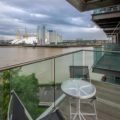
About 150 leaseholders demonstrated in Docklands on Saturday following the fire the day before at Ballymore’s new Providence Wharf site.
The leaseholders are furious at the slow pace of remediation at the site – and the fact that Ballymore, a provider builder owned by the Mulryan family, are paying in only £500,000 of the estimated £12 million bill. This contribution was offered originally when the bill appeared to be only £2 million, but it has not increased.
The New Providence Wharf leaseholders were joined by many others from elsewhere, and the local MP Apsana Begum, Tower Hamlets mayor John Biggs, the LKP team, representatives of UKCAG and Katherine O’Riordan, senior parliamentary advisor to Sir Peter Bottomley, who distributed sandwiches to the demonstrators.
In spite of strong competition, Ballymore seems to be the most detested housebuilder in London, and many leaseholders present had also contributed to the devastating article in the Financial Times about the company:
Ballymore – like other Irish developers the Comer brothers and Galliard – keep hold of the freeholds of their sites and manage them. The FT articles was extraordinary in the number of leaseholders so frustrated that they were prepared to speak publicly of their issues with the company, whatever the consequences on the value of their homes.
Today the New Providence Wharf Leaseholders and Residents Association wrote the following to Communities Secretary Robert Jenrick:
Dear Mr Jenrick,
We are writing this open letter to you on behalf of the residents and leaseholders of New Providence Wharf following the disastrous fire at the development on 7th May 2021 which left 2 people hospitalised, 40 more needing medical treatment and a number homeless.
Events over the weekend are a further graphic reminder of the urgent need for the government to take decisive action on the unresolved issue of building safety and aluminium clad residential properties. What has been put in place to date has been too slow and remains inadequate, and this is something that we have pointed out time and again to you, the extended Government and the London Borough of Tower Hamlets.
We are asking you to now make a public commitment to take personal leadership and drive through the speedy resolution needed to ensure no more lives are lost and that the safety and financial certainty of the hundreds of thousands of people affected by the cladding scandal are ensured.
As Secretary of State for Housing, Communities and Local Government this is your responsibility. Post-Grenfell, this commitment must be at the top of the agenda and well before any other interests, whether financial, those of developers and freeholders, or any other parties.
We are asking you make it your priority. Anything less would represent a failure to meet your obligations, to fulfil your duty to the public and to shoulder the moral obligation that rests with you. We look forward to your early response. In the meantime, we have written separately to the Prime Minister.
We are copying this letter to the Prime Minister, Sir Keir Starmer, Lucy Powell, Apsana Begum MP, Clive Betts MP, the Mayor of London, the Mayor of Tower Hamlets, Jeremy Pocklington [MHCLG permanent secretary]. Stephen McPartland [Tory MP] and Lord Greenhalgh [Housing and Cladding Minister].











 If government’s is tempted to dither over banning new ground rents, then this woman’s £1m a year for a small flat should clinch it …
If government’s is tempted to dither over banning new ground rents, then this woman’s £1m a year for a small flat should clinch it …





















May I suggest leaseholders withhold their service charge payments? As there are residential occupiers, leaseholders or their tenants, the landlord cannot enforce by forfeiture without first going to court for an order:s.1 Protection from Eviction Act, 1977. In these circumstances I would defy any court in the land to make such an order in view of the landlord’s failures especially if they were to place the payments allegedly due in a separate account so as to show they can pay if ordered to do so. They should also ensure that they continue to be insured.
As defendants in any proceedings brought by the landlords leaseholders should check that all the necessary Acts and Regulations were correctly followed to obtain consent to the building or any subsequent remediation. They should also have a look at the Building Regulations (Amendment) Act 2018 as Class 0 (zero) uPVC is now no longer permitted as a material which the landlords may then be ordered to remove. That in itself may generate an increased (massively?) service charge, but at least they would then be safe and their properties become sellable again. If they do so sell they would be asked to clear any arrears which any increase in the value of their flats over the acquisition cost may cover. Also if the landlords did anything ‘wrong’ in the sense of unlawful or even criminal in obtaining planning permission, regulation consent, the Court may well order them to cover the cost and not to pass it on.
How do you fund all of this? Cloudfunding is an option, but start by withholding the service charge payments and put them into a separate account so as to show that you can and indeed have paid. Also form an action committee and if possible find other leaseholders in other tower blocks which may be similarly affected. Southwark LBC was, and for all I know still may be, in the habit of certifying that it was the sole owner of its social housing blocks which is a criminal offence: see s.65(6) Town and Country Planning Act, 1990.
And finally follow the BBC Radio 4 weekly (Friday) podcasts by Kate Lamble (google:”Grenfell Tower Inquiry podcast BBC radio 4″). It is excellent and will give you lots of leads and important technical and legal information. It is also frightening about the extent to which some civil servants are, first, incompetent, second, liars, third, bullies, and fourth indifferent to the consequences of the first three. I do not know how they can sleep at night, I certainly couldn’t in their position. Good luck!
Sorry, finally, finally, do not think you are alone, there are literally MILLIONS in the same situation as yourselves. And your mortgagee banks and building societies are also worried as they security is as valuable, or valueless, as your flats. All should contact his or her MP and use any leverage you may have to try to ensure that the amendment proposed by the House of Lords, to the effect that landlords cannot pass on the cost of remediation to leaseholders in the Fire Safety Bill, now an Act, is incorporated into the Building Safety Bill presently on its way, or soon to be revived anyway, in the Commons. I cannot for the life of me think why Labour MPs should have not supported the Tory rebels when they supported this amendment in the Fire Bill which passed into law last week.
PS Normally you only have 6 weeks to challenge a planning permission and must do so by judicial review. However, you can use a defectively obtained planning permission as a defence at any time, so do not let that argument dissuade you. They will try every tactic, see the way in which Subpostmaster Bates and the other 554 were treated by the Post Office and you will get a feel about how dogged you have to be and the tactics you will come up against. Three cheers here for HHJ Peter Fraser who would have none of it.
PPS If i were to be asked to offer a solution to these long term maintenance problems it would be to provide that on any sale 1-2% of the sale proceeds be paid into a sinking fund to provide for long term ‘capital’ work, as opposed to annual maintenance, heating, lighting, insurance, etc. As things stand at present someone who, say, purchases off plan and resells a year or two after completion contributes nothing towards, say, ten year maintenance requirements, but enjoys 1-2 years’ ‘deterioration’ contribution free. Real property depreciates to some extent every day and this fact should not be overlooked.
Dear Sir, It is noted by a couple of commentators that the Providence Wharf fire started in a ‘fuse box’. If that is the case then it is possible that the ignition was preceded by an incidence of a gradual build-up of (high resistive) heat within a consumer unit/fuse box, followed by a Thermal Runaway event – whereby ignition temperatures are reached over a short period of time. To alert a third party or BMS to this gradual build-up of heat (and pre-Thermal Runaway) there is a simple device called a Thermarestor, which can facilitate this and so turn a potential fire into a maintenance issue. This device can be installed as new or retro-fitted, perhaps at EICR time, if not before.
The post-ignition issues are of course crucial, and not all fires are caused by electrical failings, but if there is a way to remove a good proportion of ignition causality, why wouldn’t a developer do this? It’s hardly an expensive measure to prevent fires such as this one. Perhaps it is because this device is not mandatory, or they are not aware of the device – and if they are not, I urge the developer (who is I believe building another residential block nearby) to get in touch with Thermarestor to understand the utility and relevance of this device.